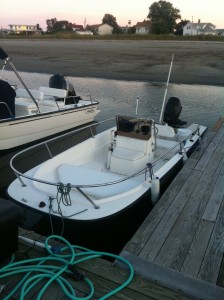







A site dedicated to discussion of these classic boats
25 Jul, 2012 No Comments
Filed in: electrical, reference, servicing
New Wahoo!s came with lots of different makes of motors: Mariners, Mercs, Hondas, Suzukis, Evinrudes, Johnsons…it doesn’t appear that Wahoo! had exclusive deals with specific manufacturers. Maybe it was the dealers who made the pairing of boat and motor. Or maybe in some instances the buyer made the choice. I don’t know.
Regardless, the motor that came on your Wahoo!, whether the original or one added by a subsequent owner, determines the wiring harness on your boat. And the wiring harness determines in part how the switches and gauges in your console are hooked up.
My 87 Striper 16.2 came with a 1981 50 horse Evinrude. This was obviously not the original motor since it predated the hull by six years. I wanted to replace it with something more recent but didn’t feel like replacing the wiring harness for this reason: Wahoo!s are a pain in the butt to change harnesses on. Maybe this can be said of most boats but it’s especially true of Wahoo!s because the sprayed-in foam below deck makes for really tight quarters when it comes to running wires and cables. (To illustrate the point, last summer I added a new Garmin Humminbird fishfinder to Seatoad. The plug for the transducer, which needed to pass under the deck and up through the wiring port in the console floor, was about the size and shape of a champagne bottle cork. I literally spent two weeks trying every way imaginable to fish that sucker through a chokepoint of cables running under the deck through a VERY narrow crevice in the foam. Wasn’t happening. I finally gave up and ran the transducer wire over the top of the deck, covering it with a protective hood of 3/4 inch PVC pipe I’d cut length-wise.)
So when I bought a “new” motor I went with a Johnson, one that could use the same OMC wiring harness already installed in my Wahoo!
Inside the console itself the wiring was spaghetti. Wires running every which way, some hooked up to nothing at all. The only working gauge on the dashboard was the tach and even on that the backlight didn’t work. It took awhile but I finally got most of it straightened out. First thing I did was install a fuse hub like this for all fused accessories. I also installed a bus bar for all the various ground wires that were spliced together all over the place like a tangle of mating eels. Where wires were just barely long enough to reach the post they were supposed to reach I lengthened them to relieve the strain on them. And every join I sheathed with heat shrink rap or electrical tape.
Really useful in getting things back together and ensuring everything was connected properly was this OMC wiring diagram from Continuous Wave. Continuous Wave has lots of other very useful reference material as well.
In the end, two of the existing non-working gauges I decided not to bother with. The tilt/trim gauge really doesn’t tell you anything you can’t see with your own eye. And the speedometer is superfluous these days–I can get my speed from my GPS. I left both gauges in place for now, they’re just not hooked up. Eventually I’d like to replace the tilt/trim gauge with a dash-mounted fuel gauge. The other I don’t know yet.
There are some still-unsolved mysteries in the wiring, such as the the engine alarm that won’t turn off and and a superfluous accessories ground ground wire. But I’ll save those for another post.
13 Jul, 2012 No Comments
Filed in: customization, servicing
 These are notes to myself mostly and may be of little interest to visitors of the site. But then again you never know…
These are notes to myself mostly and may be of little interest to visitors of the site. But then again you never know…
Finally got the boat in the water July 6, just in time for the Blessing of the Fleet the next day. The Blessing went great, a fun party with kids playing on the beach while the grownups downed barbeque and beer. Later in the evening there was a DJ doing 60s-friendly music and there was dancing on the docks. Only hitch was that the priest never showed up. So the 2012 Point of Pines Yacht Club is for the moment an unblessed fleet.
As with 2011 I was disappointed how at long it took me to get the boat in the water. But I did get a lot of work done including new bottom paint, a new fuel fill and hose, a number of patches to the fiberglass, raising the floors of the storage compartments, sorting through the wiring in the console, adding doel fins to the engine, relocating the fishfinder transducer, painting the console dashboard, painting the engine, repairing a broken section of the wiring/steering harness through-hull rigging tube, straightening a bent skeg, and refinishing all the wood. Not too shabby considering a lot of rainy weekends and that I was also planting two separate gardens, painting the garage, and going to my son’s little league games three times a week.
Remembering last year’s launch where a mile from the dock on my way to the yacht club I slammed into some rocks and dinged the prop pretty good, this year I looked at the maps more carefully and kept right to the channels. A nice, easy five mile run with no worries.
Some of the repairs/modifications I made before launching this year that seem to have actually improved things:
Stuff I either didn’t get to in the off-season or which needs fixing:
findre August 9, 2015
findre August 9, 2015
findre August 9, 2015
Lcolon7 June 23, 2015
MikeQ June 24, 2015